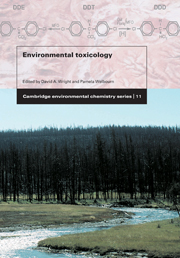Book contents
- Frontmatter
- Contents
- Foreword
- Preface
- Abbreviations
- Acknowledgements
- 1 The emergence of environmental toxicology as science
- 2 The science of environmental toxicology: Concepts and definitions
- 3 Routes and kinetics of toxicant uptake
- 4 Methodological approaches
- 5 Factors affecting toxicity
- 6 Metals and other inorganic chemicals
- 7 Organic compounds
- 8 Ionising radiation
- 9 Complex issues
- 10 Risk assessment
- 11 Recovery, rehabilitation, and reclamation
- 12 Regulatory toxicology
- 13 An overall perspective, or where to from here?
- Glossary
- Index
7 - Organic compounds
Published online by Cambridge University Press: 05 June 2012
- Frontmatter
- Contents
- Foreword
- Preface
- Abbreviations
- Acknowledgements
- 1 The emergence of environmental toxicology as science
- 2 The science of environmental toxicology: Concepts and definitions
- 3 Routes and kinetics of toxicant uptake
- 4 Methodological approaches
- 5 Factors affecting toxicity
- 6 Metals and other inorganic chemicals
- 7 Organic compounds
- 8 Ionising radiation
- 9 Complex issues
- 10 Risk assessment
- 11 Recovery, rehabilitation, and reclamation
- 12 Regulatory toxicology
- 13 An overall perspective, or where to from here?
- Glossary
- Index
Summary
The nature of organic compounds
All organic compounds contain carbon, and nearly all contain hydrogen and have a least one carbon-hydrogen bond. The simplest organic compounds contain only carbon and hydrogen and are called hydrocarbons. Alkanes are hydrocarbons in which C and H are linked by single covalent bonds consisting of two shared electrons. They may exist as straight chains, branched chains, or cycloalkanes, ring-like structures. The general formula for straight-chain or branched-chain alkanes is CnH2n+2, and it is CnH2n for cycloalkanes. Some alkanes and alkane derivatives are shown in Figure 7.1. Alkenes, also called olefins, contain double bonds consisting of four shared electrons (e.g., ethylene, H2C=CH2, Figure 7.2). Alkynes have triple C bonds consisting of six shared electrons (e.g., acetylene, HC≡CH).
It is possible for two or more compounds to have the same chemical formula yet have the constituent atoms arranged in different ways. Different configurations of similarly formulated compounds are called isomers. For example, structural isomers result from straight-chain or branched alkanes containing the same number of carbon atoms (e.g., pentane, 2-methyl butane, Figure 7.1). In cis-trans isomers, the order of the constituent atoms doesn't change although the spatial relationship between them is altered (e.g., dichloroethylene, Figure 7.2).
Aromatic or aryl compounds are based on a carbon ring structure, usually the 6C benzene ring, which unusually has strong bonding between adjacent carbon atoms and a low (1 : 1) hydrogen to carbon ratio.
- Type
- Chapter
- Information
- Environmental Toxicology , pp. 349 - 407Publisher: Cambridge University PressPrint publication year: 2002



